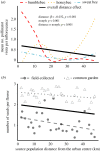Multivariate phenotypic divergence along an urbanization gradient
- PMID: 32991825
- PMCID: PMC7532719
- DOI: 10.1098/rsbl.2020.0511
Multivariate phenotypic divergence along an urbanization gradient
Abstract
Evidence suggests that natural populations can evolve to better tolerate the novel environmental conditions associated with urban areas. Studies of adaptive divergence in urban areas often examine one or a few traits at a time from populations residing only at the most extreme urban and nonurban habitats. Thus, whether urbanization drives divergence in many traits simultaneously in a manner that varies with the degree of urbanization remains unclear. To address this gap, we generated seed families of white clover (Trifolium repens) collected from 27 populations along an urbanization gradient in Toronto, Canada, grew them in a common garden, and measured 14 phenotypic traits. Families from urban sites had evolved later phenology and germination, larger flowers, thinner stolons, reduced cyanogenesis, greater biomass and greater seed set. Pollinator observations revealed near-complete turnover of pollinator morphological groups along the urbanization gradient, which may explain some of the observed divergences in floral traits and phenology. Our results suggest that adaptation to urban environments involves multiple traits.
Keywords: Trifolium repens; cline; rapid evolution; urban evolution.
Conflict of interest statement
The authors declare no conflicts of interest.
Figures


Similar articles
-
Urbanization and a green corridor do not impact genetic divergence in common milkweed (Asclepias syriaca L.).Sci Rep. 2023 Nov 22;13(1):20437. doi: 10.1038/s41598-023-47524-8. Sci Rep. 2023. PMID: 37993590 Free PMC article.
-
Urbanization drives the evolution of parallel clines in plant populations.Proc Biol Sci. 2016 Dec 28;283(1845):20162180. doi: 10.1098/rspb.2016.2180. Proc Biol Sci. 2016. PMID: 28003451 Free PMC article.
-
Contrasting the effects of natural selection, genetic drift and gene flow on urban evolution in white clover (Trifolium repens).Proc Biol Sci. 2018 Jul 18;285(1883):20181019. doi: 10.1098/rspb.2018.1019. Proc Biol Sci. 2018. PMID: 30051843 Free PMC article.
-
Urban driven phenotypic changes: empirical observations and theoretical implications for eco-evolutionary feedback.Philos Trans R Soc Lond B Biol Sci. 2017 Jan 19;372(1712):20160029. doi: 10.1098/rstb.2016.0029. Philos Trans R Soc Lond B Biol Sci. 2017. PMID: 27920374 Free PMC article. Review.
-
Evolution of life in urban environments.Science. 2017 Nov 3;358(6363):eaam8327. doi: 10.1126/science.aam8327. Science. 2017. PMID: 29097520 Review.
Cited by
-
Is urbanization a driver of aboveground biomass allocation in a widespread tropical shrub, Turnera subulata (Turneroideae - Passifloraceae)?J Plant Res. 2024 Sep;137(5):879-892. doi: 10.1007/s10265-024-01560-1. Epub 2024 Jul 17. J Plant Res. 2024. PMID: 39014142
-
Urbanization and a green corridor do not impact genetic divergence in common milkweed (Asclepias syriaca L.).Sci Rep. 2023 Nov 22;13(1):20437. doi: 10.1038/s41598-023-47524-8. Sci Rep. 2023. PMID: 37993590 Free PMC article.
-
Phenotypic clines in herbivore resistance and reproductive traits in wild plants along an agricultural gradient.PLoS One. 2023 May 31;18(5):e0286050. doi: 10.1371/journal.pone.0286050. eCollection 2023. PLoS One. 2023. PMID: 37256895 Free PMC article.
-
The effect of temperature and invasive alien predator on genetic and phenotypic variation in the damselfly Ischnura elegans: cross-latitude comparison.Front Zool. 2023 Apr 10;20(1):13. doi: 10.1186/s12983-023-00494-z. Front Zool. 2023. PMID: 37032330 Free PMC article.
-
Phenotypic and genotypic divergence of plant-herbivore interactions along an urbanization gradient.Evol Appl. 2022 Apr 25;15(5):865-877. doi: 10.1111/eva.13376. eCollection 2022 May. Evol Appl. 2022. PMID: 35603025 Free PMC article.
References
-
- McDonnell MJ, Hahs AK, Breuste JH. 2009. Ecology of cities and towns: a comparative approach. Cambridge, UK: Cambridge University Press.
-
- Oke TR. 1973. City size and the urban heat island. Atmos. Environ. (1967) 7, 769–779. (10.1016/0004-6981(73)90140-6) - DOI
Publication types
MeSH terms
Associated data
LinkOut - more resources
Full Text Sources
Miscellaneous

